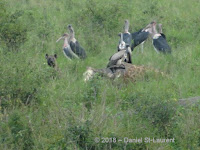MARABOU STORK
MARABOU STORK (Leptoptilos crumenifer) (See images below)
The Marabou Stork is not necessarily the cutest bird in terms of habits but it is essential in its environment. It is very tall, almost as much as a human adult. Its wingspan is probably the largest at about 12 feet (3.7 meters). It is found in Africa, south of the Sahara region, and can be seen both in wet and arid locations.
The name ‘marabou’ refers to ‘quiet’ in Arabic, and the word ‘crumenifer’ in the Latin name refers to the bird’s (pink) gular sac, or ‘carrying a pouch for money’.
The marabou stork is a partial scavenger, and will feed on carcasses with vultures. Because of its diet (which includes even faeces) it doesn’t have feathers on its head, only sparse ‘hair’. Since often its head and upper neck will be stained with blood from carcasses, they’re easier to clean without feathers, just like the vultures. To feed their young they will hunt live animals however.
The bill is creamy-beige, straight and conical. The large gular sac can sometimes be seen hanging almost to the ground. The back and wings are dark grey, and the under parts white. The legs are grey. This species of bird will defecate on its legs in hot weather to keep them cool, just like vultures do.
Marabou storks have adapted to the human habitat and now are seen breeding and feeding at dumps, and can even approach humans to be fed. They are not very choosy in terms of garbage for a meal – they are known to eat really inedible trash.
The Marabou Stork is not necessarily the cutest bird in terms of habits but it is essential in its environment. It is very tall, almost as much as a human adult. Its wingspan is probably the largest at about 12 feet (3.7 meters). It is found in Africa, south of the Sahara region, and can be seen both in wet and arid locations.
The name ‘marabou’ refers to ‘quiet’ in Arabic, and the word ‘crumenifer’ in the Latin name refers to the bird’s (pink) gular sac, or ‘carrying a pouch for money’.
The marabou stork is a partial scavenger, and will feed on carcasses with vultures. Because of its diet (which includes even faeces) it doesn’t have feathers on its head, only sparse ‘hair’. Since often its head and upper neck will be stained with blood from carcasses, they’re easier to clean without feathers, just like the vultures. To feed their young they will hunt live animals however.
The bill is creamy-beige, straight and conical. The large gular sac can sometimes be seen hanging almost to the ground. The back and wings are dark grey, and the under parts white. The legs are grey. This species of bird will defecate on its legs in hot weather to keep them cool, just like vultures do.
Marabou storks have adapted to the human habitat and now are seen breeding and feeding at dumps, and can even approach humans to be fed. They are not very choosy in terms of garbage for a meal – they are known to eat really inedible trash.
 |
| Marabou stork side view, Tanzania |
 |
| Marabou storks around giraffe carcass |
 |
| Marabou stork front view, Tanzania |